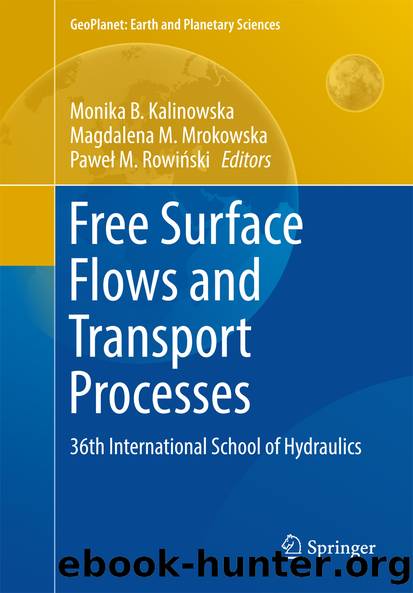Free Surface Flows and Transport Processes by Monika B. Kalinowska Magdalena Maria Mrokowska & Paweł Mariusz Rowiński

Author:Monika B. Kalinowska, Magdalena Maria Mrokowska & Paweł Mariusz Rowiński
Language: eng
Format: epub
Publisher: Springer International Publishing, Cham
In the second (II) and third model (III), water structure was introduced in the flume with a totally or partially sandy bed (Fig. 1b, c); the weir was made of stone with four slots (summary area of slots A sII = 0.018 m2 and A sIII = 0.035 m2). The weir was situated downstream the 4.0 m section of the sandy bed. In the third model, a 0.35 m long section of the bottom, immediately downstream the weir was reinforced. Upstream the weir, the thickness of the sand layer was 5 cm, while downstream it was 25 cm. Sandy bed above the structure was washed out by the approaching flow and the sediment load was moved out from the upper part towards the lower part of the water structure, ensuring live-bed conditions. Velocity of the flowing water in the structure’s slots is increased because of flow area reduction. Therefore, in this case, the shear stress reinforcement is a result not only of roughness variability of material, but also of the velocity increment. Local scour was allowed to form gradually, until live-bed equilibrium conditions were obtained, just to achieve a stable shape, characterized by geometrical parameters such as length l s , medium and maximal depth z m and z max (Fig. 4).
During an experimental research, there were few cases in which the scour length l s had seemed to be slightly longer than the total length of erodible part of the bed L (Fig. 2)—i.e. the scour hole would have been longer if erodible bed had been longer too. It such cases, its value was extrapolated.
Fig. 2Scheme of local scour forming in washable area of sandy bed in model III, where: A—solid bottom; B—sandy washout bed; C—stone weir; H 1 , H 2 , H 3 —water depths; Q w —water flow discharge; S 1 , S 2—energy grade line slope; z max —maximal depth of local scour while achieving stabilization in time t t with st scour shape (live-bed equilibrium scour depth); s 1 , s 2 , s t —bed elevation below the weir while duration of experiment in time, D-D—computational cross-section, E-E —cross section in water structure’s region for water velocity calculations
Download
This site does not store any files on its server. We only index and link to content provided by other sites. Please contact the content providers to delete copyright contents if any and email us, we'll remove relevant links or contents immediately.
| Automotive | Engineering |
| Transportation |
Whiskies Galore by Ian Buxton(41534)
Introduction to Aircraft Design (Cambridge Aerospace Series) by John P. Fielding(32892)
Small Unmanned Fixed-wing Aircraft Design by Andrew J. Keane Andras Sobester James P. Scanlan & András Sóbester & James P. Scanlan(32576)
Craft Beer for the Homebrewer by Michael Agnew(17936)
Turbulence by E. J. Noyes(7704)
The Complete Stick Figure Physics Tutorials by Allen Sarah(7144)
Kaplan MCAT General Chemistry Review by Kaplan(6601)
The Thirst by Nesbo Jo(6442)
Bad Blood by John Carreyrou(6280)
Modelling of Convective Heat and Mass Transfer in Rotating Flows by Igor V. Shevchuk(6227)
Learning SQL by Alan Beaulieu(6039)
Weapons of Math Destruction by Cathy O'Neil(5837)
Man-made Catastrophes and Risk Information Concealment by Dmitry Chernov & Didier Sornette(5655)
Digital Minimalism by Cal Newport;(5394)
Life 3.0: Being Human in the Age of Artificial Intelligence by Tegmark Max(5193)
iGen by Jean M. Twenge(5164)
Secrets of Antigravity Propulsion: Tesla, UFOs, and Classified Aerospace Technology by Ph.D. Paul A. Laviolette(4999)
Design of Trajectory Optimization Approach for Space Maneuver Vehicle Skip Entry Problems by Runqi Chai & Al Savvaris & Antonios Tsourdos & Senchun Chai(4845)
Electronic Devices & Circuits by Jacob Millman & Christos C. Halkias(4751)
